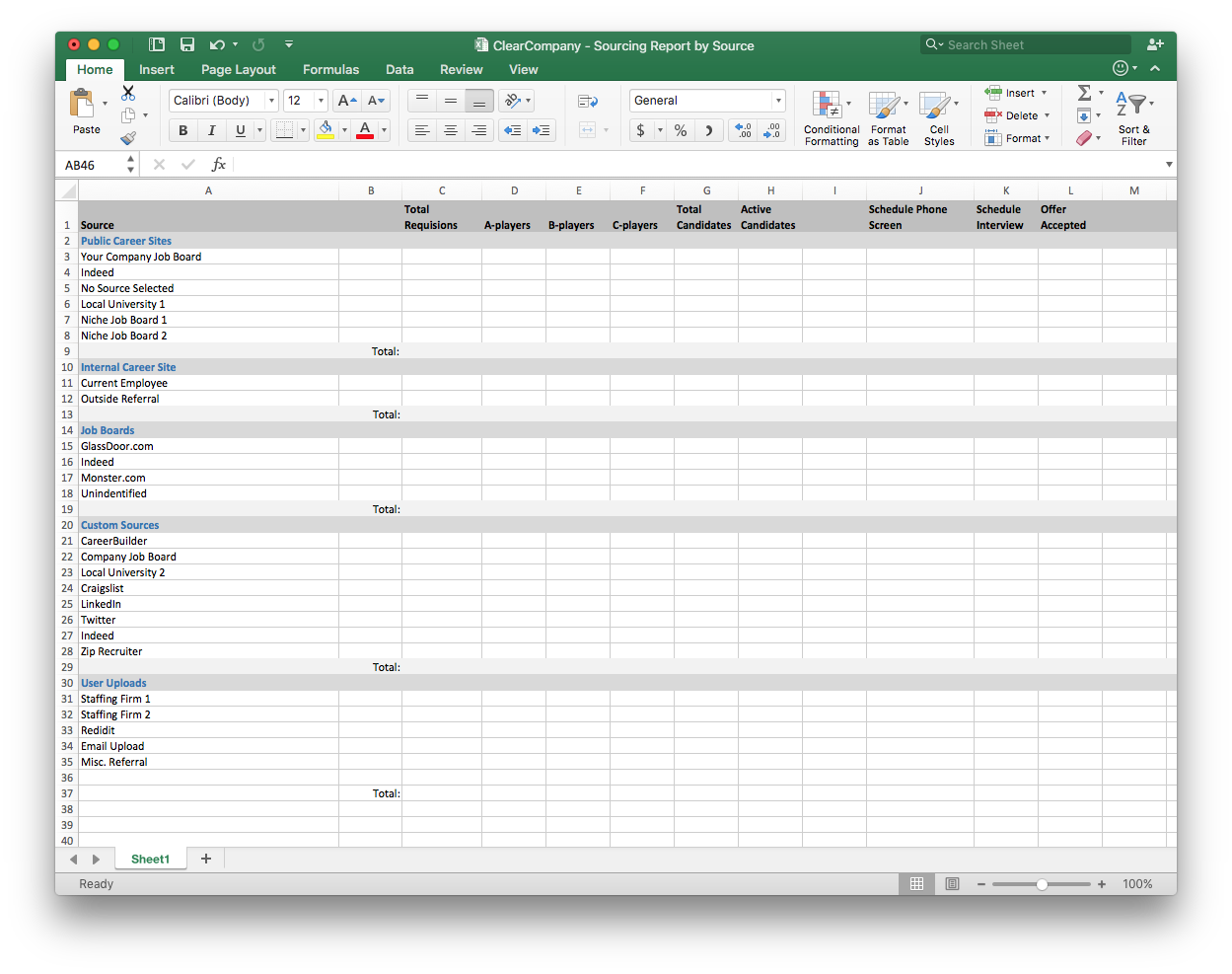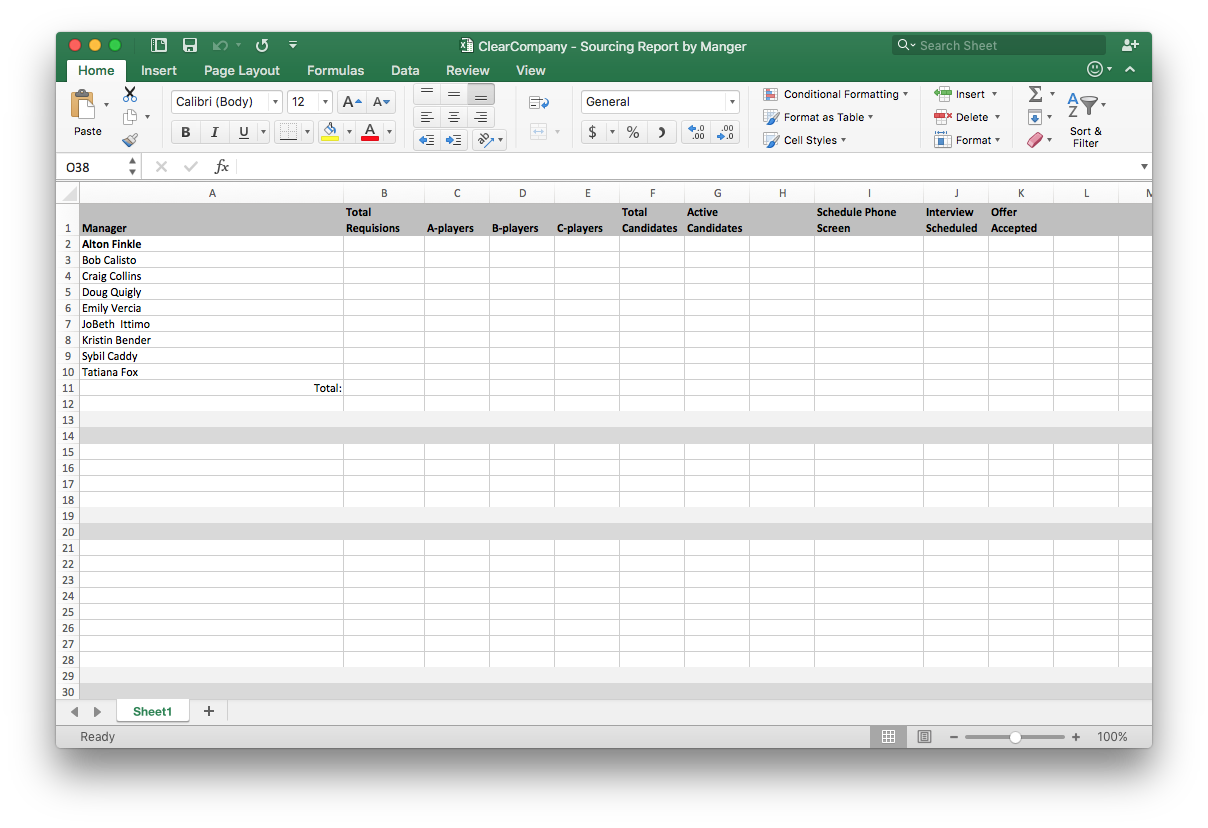Best Practices for Achieving Talent Success Maturity
Building a Sourcing Plan for More Effective Recruiting
With insight from

Libby Sartain
Former CHRO, Professional Board Member
Libby Sartain is an independent advisor, working with companies on human resource issues. With more than 30 years of experience in human resources, she is also an author and frequent speaker, using her HR leadership and management experience at companies in technology, transportation and manufacturing. She led human resources at Yahoo! and Southwest Airlines during transformative periods. Both companies were among Fortune magazine’s “Best Places to Work” during her tenure. She is the former board chair of the Society for Human Resource Management and is on the board of Manpower Group and is the Vice Chair of the Board of AARP.
With research and insight publicly available from publicly available resources by the Society of Human Resource Management
-
Who it’s for:
HR managers, recruiters -
What you’ll get:
A template for a source performance report -
Why you need it:
To find qualified candidates faster and avoid wasteful spending -
When it applies in the talent success process:
When you start looking for candidates for an opening
The first step toward hiring more A-players is finding them. This article gives you a simple, four-step process for identifying and using candidate sources and practical, easy ways to measure the effectiveness of those sources.
Candidate Sourcing: What It Is, Really
Candidate sourcing is about finding and engaging potential candidates who have not applied to your company, or who previously applied and were not hired.
Here’s a clear and complete definition of sourcing from the Society for Human Resource Management:
Sourcing is the proactive searching for qualified job candidates for current or planned open positions. It is not the reactive function of reviewing resumes and applications sent to the company in response to a job posting or pre-screening candidates.
Whether you find candidates on job boards, through social networks or employee referrals, or from other candidate-supplied information, effective and successful sourcing requires a strategic plan.
Better Sourcing in Four Steps
The four-step sourcing plan described in this article will help you source more effectively and assess the results of your efforts, so you can refine your process going forward.
- Step 1: Find Potential Sources of Candidates
- Step 2: Create an Outreach Plan
- Step 3: Track Sourcing Progress and Effectiveness
- Step 4: Analyze the Results and Apply Them to the Next Campaign
Of course, successful candidate sourcing can only come after you’ve created effective job descriptions for your job postings. For assistance, read our library article “Job Descriptions (and Postings!) That Sell.”
Step 1: Find Potential Sources of Candidates
Sourcing can include everything from advertising on job boards to conducting highly targeted outreach efforts to reach very specific, narrowly qualified candidates. The list below covers a variety of major categories of sourcing channels and methods to consider for your next opening.
Start with Your Company Website
If you’re not posting every opening on your company’s website, start now.
At the least, advertising jobs on your company website is more or less free, is a best practice for compliance reasons, and is the place where many candidates who hear about your openings somewhere else will go to learn more about your company and apply for the job.
The company website is also becoming one of the primary places where people get interested about working for a company, says Libby Sartain, Former CHRO, Professional Board Member.
“The best ones,” Sartain says, “are more about marketing and advertising than they are about simply posting open jobs and giving people a way to apply.”
Get Specific
In today’s competitive job market, you should try to make the job postings on your company website as granular and targeted as possible, and use video and other media to give the most detailed and realistic job description possible.
- Rather than saying, “See our open positions,” you might say, “Are you a techie nerd and proud of it? We’re hiring.”
- For a job in the business office, you might say, “Are you a numbers geek? We’re hiring.”
Using YouTube or other programs, you can post videos to show a day on the job and at the same time, make an emotional connection with the applicant by making the job real to them.
Also, include an open invitation to job seekers on your website. All you need is a line like, “Think you’d be an excellent fit but don’t see the right opening? Click here to submit your resume for future consideration.”
Eight Other Potential Sources for Proactively Finding Candidates
Job board posting
Online job boards shouldn’t be your only sourcing channel, but they still play an important role. The key is to use job boards thoughtfully and deliberately. Don’t just post every job to a particular board because that’s the way you’ve done it for years. The reporting tools detailed later in this article will help you evaluate the performance of your postings, optimize them, and focus your spending on boards that deliver A-players.
Also, pay special attention to job boards that allow you to brand your company rather than simply post a job description. Indeed is a good example of a board that lets you give a better feel for your company.
Boolean sourcing using Google
Boolean sourcing lets you find resumes and cover letters that are stored within personal websites, job boards, and social platforms all over the web by using a unique set of search commands. Click here for a great introduction to Boolean searching for sourcing from ERE Media.
Resume databases
Many job boards (including Monster and CareerBuilder) sell access to be able to search their database of job seekers, using keywords and other criteria. This typically costs significantly more than other online resources, but it gives you access to a much larger candidate pool. Higher-cost sources can still be cost-effective, if they deliver more qualified candidates.
Social sourcing I: LinkedIn, Facebook, and Twitter
LinkedIn, Twitter, Facebook, and other social media sites offer unique tools to proactively find candidates. With LinkedIn, you use Boolean logic and also search through user groups. Facebook’s Graph Search tool lets you search for individuals using specific queries, such as “Java programmer in Denver, Colorado.” You can similarly use Facebook and LinkedIn to find people based on their job titles and target them with messages about specific open positions (e.g., “Acme has openings for HR managers. Click here.”). You can use Twitter’s search engine to identify professionals by specific keywords, phrases, and locations.
Click here to learn how to do Boolean searches on LinkedIn.
Click here for an easy guide to using Facebook’s Graph Search by Social Media Examiner.
Click here for a good blog article on seven ways to use Twitter’s search engine.
Social sourcing II: The virtual water coolers
Whatever the occupation or profession, odds are a specialized community site exists where people hang out, swap tips, and share career advice. These include everything from huge sites like GitHub and Stack Overflow to smaller sites like EMT City and Practical Machinist. On many of these boards, you can buy banner ads, post jobs to private boards, and interact with members publicly or through private messages. One way to find them is to do a web search for “[JOB TITLE] discussion forum.”
Your company’s past applicants
The easiest candidates to find should be the ones you’ve already found. An applicant tracking system (ATS) makes it easy to create and maintain a database of candidates who were promising but didn’t work out the first time around. A good system will make it easy to conduct searches, create or maintain lists of candidates for future use, and send mailings to re-engage with them.
The people who are watching you
When was the last time you looked at the “Who’s viewed your profile” section of LinkedIn? As ERE Media says, this can be a fountain of information, because it can provide information on a few things: who is interested in your company but maybe hasn’t applied yet, and who you may have already reached out to that has looked at your profile (there’s a chance that your initial connection with them at least piqued their curiosity) and may be worth a follow-up.
Your own employees
Statistics show that your own employees are the best source of qualified candidates who also fit your company culture. Libby Sartain says that when she was head of HR for Southwest Airlines, 30 to 35 percent of their hires came from internal referrals. “And they were the best candidates over time,” she said.

Libby’s Take
Recruiters these days often rely on the internet to source and engage candidates, when that may not be the best strategy. Sometimes you need to go — physically or virtually — where your best candidates might be hanging out.
For example, when I was head of HR at Yahoo, we sent our recruiters to “hack-a-thons” to meet and get to know the best coders. At Southwest Airlines, we learned that many baggage handlers liked to work out. So, when we had openings for baggage handlers, we distributed fliers at local gyms.
I’ve worked with recruiters to find customer service agents through large churches that have job sites for their members. Local and regional professional associations are great sources for finding candidates in HR, accounting and finance, marketing, legal and other roles.
Finally, don’t forget diversity outreach. To bring in a diverse applicant pool, you may try reaching out through churches that serve a minority population or professional organizations for minority members, such as the National Black MBA Association.
— Libby Sartain, Former CHRO, Professional Board Member
Step 2: Create an Outreach Plan
After you’ve identified your potential sources of candidates, you’ll want to create a campaign plan for the job you’re trying to fill. The key parts of this plan are determining who you’re trying to find, where you’re going to go looking for them, and how you’re going to make contact.
Five Tips for Creating a Great Sourcing Outreach Plan *
Know the role
Your first step should be to make sure you have a clear and engaging job description. Click here for our guide on building job descriptions that sell. You’ll use this in posting ads as well as writing any emails or other types of communications. Consistent messages that reinforce each other are the most effective.
Understand your audience
Knowing who you’re trying to reach is the starting point to knowing where to find them, and the most appealing way to promote your job and company to them. While everybody appreciates good benefits, what a junior engineer likes and what a senior salesperson gets excited about are likely to be different. Talk to current employees in the role and department you’re working on to understand them better and what aspects of the opportunity are most engaging.
Try multiple channels
Marketing is at its core a process of experimentation, measurement, and refinement. If you’ve always used a certain job board, use it, but try another one as well and see how the results compare. Also keep in mind that different sources — and different types of sources — may respond to different approaches. If it doesn’t work the first time, try again, but try differently.
A/B test
If you’re having trouble getting candidates to apply to a certain job post, there may be a different way to accurately or more engagingly title the job. Or you may need to try emphasizing different parts of the job or highlight your company upfront. If you’re sending an email to 100 potential candidates, break it into two groups of 50 and try a slightly different subject line to each group. See which one gets more responses.
Create multiple touch points
Just because someone saw your job post once, or was sent one email, that doesn’t mean they actually got your message. Marketers today strive to deliver messages to consumers through multiple channels over a period of time to create familiarity and build engagement. Develop three to five emails or job posts and deliver them across multiple weeks, leveraging collateral and marketing materials to engage and drive awareness.
Step 3: Track Sourcing Progress and Effectiveness
Basic data collection is critical to successful candidate sourcing. You want to monitor key metrics of your sourcing efforts to be able to determine what works and what doesn’t, and adjust your outreach plans accordingly.
A Tip for Easier Source Tracking
An easy and effective way to physically identify and manage the source of your candidates is to apply source-specific URLs to your job posts. ATSs and job boards usually allow you to generate a source-specific URL when you create a post. When an applicant applies for a job and the form asks them how they heard about the job, the form should be auto-filled with the information of the job posting, which you will be able view and manage as a tracking URL.
The simplest way to track progress and effectiveness of source campaigns is to report the results of source tracking in a sourcing performance report or a basic Excel or similar spreadsheet file. You can find a template in the next section of this article, A Sourcing Performance Report.
Below are key data points (metrics) to consider collecting to build your performance report.
| Key Performance Indicators (KPIs) | For each job posting, how many candidates will you want to add to your recruiting pipeline? |
| Diversity | How many candidates self-identified as minorities in each channel? |
| Job Views | This is how many people are actually seeing a job you’ve posted. |
| Applications (or clicks to your ATS) | For each job, on each source, how many candidates apply. |
| Email Conversions | Track how many emails for each job, and each A/B test, resulted in an application. |
| Source of Hire | Most ATSs make it easy to track and report source of hire. Every candidate who enters the system is tagged with a specific source of entry, such as job boards, social networks, etc. |
| Time to Fill | SHRM defines time to fill as the number of days from when a job requisition was opened until the offer was accepted by a candidate. |
| Total Applications | Track the performance of each job posting on each source. |
| Interviews Offered | Track how many applicants to each job post on each source were offered interviews. |
| Offers Accepted | Track how many applicants to each job post on each source received job offers. |
Step 4: Analyze the Results and Apply Them to the Next Campaign
With the results of your sourcing data collected in a performance report, you can begin to analyze the numbers and use that information to refine your outreach plans going forward.
Basic Candidate Sourcing Analytics
Key Performance Indicators (KPIs)
In raw numbers (no calculation required), how did each job posting perform compared with your goals? How does this compare with your KPIs for other sourcing channels? Look at the outliers. You may need to stop using low-performing channels, or at least change your style or logic for posting there. Or you may need to consider shifting more posts to your higher-performing sourcing channels.
Job Views
Again using raw numbers (no calculation required), the number of views can tell you if a sourcing channel is performing well or if it could use a little boost (like more promotion or a more enticing headline).
Apply Rate
This is your job views divided by your applications for each job posting. This critical metric judges the effectiveness of each posting and helps you easily identify any outliers.
Interview-to-offer Ratio
Dividing the number of interviews from a sourcing channel by the number of offers you ultimately make has two important benefits. It helps you easily identify where your best candidates are coming from. And, if the number is too high, tells you that you’re interviewing too many candidates and should re-evaluate your job descriptions, how you screen your candidates, or both.
Offer-to-acceptance Ratio
Dividing the number of accepted job offers received through a sourcing channel by the number of offers you made to candidates from that same channel tells you a lot about your screening and interviewing process. If the ratio is low, it could mean there are mismatched or unclear expectations, a poor culture fit, or that candidates are taking offers from competitors or are staying where they are. Keep tabs on where you lose candidates and find ways to improve those areas.
Email Conversion Rate
Recruiting guru and author Lou Adler says a good response rate is over 50 percent. Less than this means you’re not targeting your list tightly enough or you need to reconsider your job description, your email subject line, or how the email is designed.
Diversity Ratios: Applicants, Offers, Hires
For each channel, these three diversity ratios can help you source more effectively to better meet your company’s diversity goals and inclusion programs, and comply with federal and state employment laws.
Template for a Sourcing Performance Report
A spreadsheet is a great tool to make sure you’ve gathered all the data and have it in a format to analyze the effectiveness of your sources for potential candidates — your sourcing channels. If you click on the image below, it will open an Excel spreadsheet populated with:
- Suggested sourcing performance data to collect (See Step 3: Track Sourcing Progress and Effectiveness in the previous section of this article for more information about these metrics.)
- Recommended performance analytics and their formulas (See Step 4: Analyze the Results and Apply Them to the Next Campaign in the previous section of this article for a deeper dive into these analytics.)

